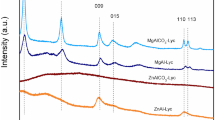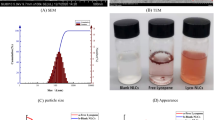Abstract
Lycopene is one of the most powerful natural antioxidants with demonstrated capacity to protect and reduce risks against some diseases. It has also been used as additive in polymers for packaging. Hydrophobicity is the main disadvantage of this compound, especially to prepare edible formulations and assimilation in the body; to improve this, emulsions have been formulated although they provide a low content of lycopene. For this study, we prepared a hybrid composite material with layered double hydroxides (LDHs) and 54% of lycopene. The composite is easily dispersed in water and when subjected to aqueous media to simulate a pass through stomach (pH 1.2), small intestine (pH 6.8) and large intestine (pH 7.4), where the composite released 84.5%, 92.8 and 96.7% of lycopene, respectively. The composite was analyzed in each step. The antioxidant capacity of the composite was similar to that of pure lycopene, although the content of lycopene was partial. Electron paramagnetic resonance (EPR) and X-ray photoelectron spectroscopy (XPS) indicated that the cations from LDH particles also contribute to capture unpaired electrons, thus producing a synergy in the antioxidant activity. Further, UV–vis and infrared spectroscopies demonstrated that the lycopene molecule was protected within along the pass through the three simulated media. This composite is an alternative vehicle to prepare lycopene supplements for oral consumption, maximizing the stability, and enhancing the release and therapeutic profile. This composite is also an alternative antioxidant additive for polymers or biofuels.
















Similar content being viewed by others
Availability of data and materials
G.G.C.A. should be contacted if someone wants to request the data.
References
Aghel N, Ramezani Z, Amirfakhrian S (2011) Isolation and quantification of lycopene from: tomato cultivated in Dezfoul. Iran Jundishapur J Nat Pharm Prod 6(1):9–15
Ahmed AAA, Talib ZA, Hussein MZ (2013) Influence of metallic molar ratio on the electron spin resonance and thermal diffusivity of Zn-Al layered double hydroxide. J Nanomater 2013:1–9. https://doi.org/10.1155/2013/639354
Akhoond Zardini A, Mohebbi M, Farhoosh R, Bolurian S (2018) Production and characterization of nanostructured lipid carriers and solid lipid nanoparticles containing lycopene for food fortification. J Food Sci Technol 55(1):287–298. https://doi.org/10.1007/s13197-017-2937-5
Alemán J, Chadwick AV, He J, Hess M, Horie K, Jones RG, Kratochvíl P, Meisel I, Mita I, Moad G, Penczek S, Stepto RFT (2007) Definitions of terms relating to the structure and processing of sols, gels, networks, and inorganic-organic hybrid materials (IUPAC recommendations 2007). Pure Appl Chem 79(10):1801–1829. https://doi.org/10.1351/pac200779101801
Apak R, Güçlü K, Özyürek M, Çelik SE (2008) Mechanism of antioxidant capacity assays and the CUPRAC (cupric ion reducing antioxidant capacity) assay. Microchim Acta 160(4):413–419. https://doi.org/10.1007/s00604-007-0777-0
Arballo J, Amengual J, Erdman JW (2021) Lycopene: a critical review of digestion, absorption, metabolism, and excretion. Antioxidants 10(3):342. https://doi.org/10.3390/ANTIOX10030342
Budziak CR, Maia CMBF, Mangrich AS (2004) Transformações químicas da matéria orgânica durante a compostagem de resíduos da indústria madeireira. Quim Nova 27(3):399–403. https://doi.org/10.1590/s0100-40422004000300007
Chen JL, Zhu JH (2019) A query on the Mg 2p binding energy of MgO. Res Chem Intermed 45(3):947–950. https://doi.org/10.1007/s11164-018-3654-z
Chen B, Sun Q, Wang D, Zeng XF, Wang JX, Chen JF (2020) High-gravity-assisted synthesis of surfactant-free transparent dispersions of monodispersed MgAl-LDH nanoparticles. Ind Eng Chem Res 59(7):2960–2967. https://doi.org/10.1021/acs.iecr.9b06272
Czechowski F, Golonka I, Jezierski A (2004) Organic matter transformation in the environment investigated by quantitative electron paramagnetic resonance (EPR) spectroscopy: studies on lignins. Spectrochim Acta - Part A: Mole Biomol Spectrosc 60(6):1387–1394. https://doi.org/10.1016/j.saa.2003.10.037
dos Santos RC, Ombredane AS, Souza JMT, Vasconcelos AG, Plácido A, das Amorim AGN, Barbosa EA, Lima FCDA, Ropke CD, Alves MMM, Arcanjo DDR, Carvalho FAA, Delerue-Matos C, Joanitti GA, de Leite JRSA (2018) Lycopene-rich extract from red guava (Psidium guajava L.) displays cytotoxic effect against human breast adenocarcinoma cell line MCF-7 via an apoptotic-like pathway. Food Res Int 105:184–196. https://doi.org/10.1016/j.foodres.2017.10.045
Fontana F, Shahbazi MA, Liu D, Zhang H, Mäkilä E, Salonen J, Hirvonen JT, Santos HA (2017) Multistaged nanovaccines based on porous silicon acetalated dextran cancer cell membrane for cancer immunotherapy. Adv Mater 29(7):1–9. https://doi.org/10.1002/adma.201603239
Ghanbari N, Ghafuri H (2022) Design and preparation the novel polymeric layered double hydroxide nanocomposite (LDH/Polymer) as an efficient and recyclable adsorbent for the removal of methylene blue dye from water. Environ Technol Innov 26:102377. https://doi.org/10.1016/J.ETI.2022.102377
Gutiérrez Galán DK, Pacheco-Moisés FP, Silva Bezerra F, de Alves Matos N, González Rojas NA, Arratia-Quijada J, Carbajal Arízaga GG (2021) Hydrophilic lycopene-coated layered double hydroxide nanoparticles to enhance the antioxidant activity and the oxidative stress evaluation. Appl Nanosci 1–11:2747–2758
Hafez IH, Osman AR, Sewedan EA, Berber MR (2018) Tailoring of a potential nanoformulated form of gibberellic acid: synthesis, characterization, and field applications on vegetation and flowering. J Agric Food Chem 66(31):8237–8245. https://doi.org/10.1021/acs.jafc.8b02761
Hajikhani M, Emam Djomeh Z, Askari G (2021) Lycopene loaded polylactic acid (PLA) and PLA/copolymer electrospun nanofibers, synthesis, characterization, and control release. J Food Process Preserv 45(1):1–14. https://doi.org/10.1111/jfpp.15055
Ishigaki M, Meksiarun P, Kitahama Y, Zhang L, Hashimoto H, Genkawa T, Ozaki Y (2017) Unveiling the aggregation of lycopene in vitro and in vivo: UV-Vis, resonance raman, and raman imaging studies. J Phys Chem B 121(34):8046–8057. https://doi.org/10.1021/acs.jpcb.7b04814
Jerzykiewicz M, Barančíková G, Jamroz E, Kałuża-Haładyn A (2019) Application of EPR spectroscopy in studies of soils from destroyed forests. Appl Magn Reson 50(6):753–760. https://doi.org/10.1007/s00723-018-1055-5
Khan SB, Alamry KA, Alyahyawi NA, Asiri AM, Arshad MN, Marwani HM (2015) Nanohybrid based on antibiotic encapsulated layered double hydroxide as a drug delivery system. Appl Biochem Biotechnol 175(3):1412–1428. https://doi.org/10.1007/s12010-014-1211-9
Kim TH, Lee JA, Choi SJ, Oh JM (2014) Polymer coated caAl-layered double hydroxide nanomaterials for potential calcium supplement. Int J Mol Sci 15(12):22563–22579. https://doi.org/10.3390/ijms151222563
Kumar PVN, Elango P, Asmathulla S, Kavimani S (2017) A systematic review on lycopene and its beneficial effects. Biomedical and Pharmacology Journal 10(4):2113–2120. https://doi.org/10.13005/bpj/1335
Kura AU, Saifullah B, Cheah PS, Hussein MZ, Azmi N, Fakurazi S (2015) Acute oral toxicity and biodistribution study of zinc-aluminium-levodopa nanocomposite. Nanoscale Res Lett. https://doi.org/10.1186/s11671-015-0742-5
Kura AU, Ain NM, Hussein MZ, Fakurazi S, Hussein-Al-Ali SH (2014) Toxicity and metabolism of layered double hydroxide intercalated with levodopa in a Parkinson’s disease model. In: International Journal of Molecular Sciences (Vol. 15, Issue 4, pp. 5916–5927). MDPI AG. doi:https://doi.org/10.3390/ijms15045916
Li B, He J, Evans DG, Duan X (2004) Enteric-coated layered double hydroxides as a controlled release drug delivery system. Int J Pharm 287(1–2):89–95. https://doi.org/10.1016/j.ijpharm.2004.08.016
Li W, Yalcin M, Lin Q, Ardawi MSM, Mousa SA (2017) Self-assembly of green tea catechin derivatives in nanoparticles for oral lycopene delivery. J Control Release 248:117–124. https://doi.org/10.1016/j.jconrel.2017.01.009
Li H, Jin K, Luo M, Wang X, Zhu X, Liu X, Jiang T, Zhang Q, Wang S, Pang Z (2019) Size dependency of circulation and biodistribution of biomimetic nanoparticles: red blood cell membrane-coated nanoparticles. Cells 8(8):881. https://doi.org/10.3390/cells8080881
Liang X, Yan J, Guo S, McClements DJ, Ma C, Liu X, Liu F (2021) Enhancing lycopene stability and bioaccessibility in homogenized tomato pulp using emulsion design principles. Innov Food Sci Emerg Technol 67:102525. https://doi.org/10.1016/j.ifset.2020.102525
Lichtenberg SS, Laisney J, Elhaj Baddar Z, Tsyusko OV, Palli SR, Levard C, Masion A, Unrine JM (2020) Comparison of nanomaterials for delivery of double-stranded RNA in caenorhabditis elegans. J Agric Food Chem 68(30):7926–7934. https://doi.org/10.1021/acs.jafc.0c02840
Ma Y, Zhong L, Peng Z, Liu X, Ouyang D, Guan S (2021) Development of a highly water-soluble lycopene cyclodextrin ternary formulation by the integrated experimental and modeling techniques. AAPS PharmSciTech 22(1):1–9. https://doi.org/10.1208/s12249-020-01861-3
Maya S, Prakash T, das Madhu K, Goli D (2016) Multifaceted effects of aluminium in neurodegenerative diseases: a review. Biomed Pharmacother 83:746–754. https://doi.org/10.1016/j.biopha.2016.07.035
Meegahawaththa W, Sinhalage D, Mudannayake D (2020) Tomato (Lycopersicon esculentum L.) peel powder as a source of natural antioxidant and a colorant in stirred yoghurt. Food and Life 2020(2):87–97. https://doi.org/10.5851/FL.2020.E10
Naumkin A, Kraut-Vass A, Gaarenstroom S, & Powell C (2012, September 15). NIST X-ray Photoelectron Spectroscopy Database. NIST Inorganic Crystal Structure Database (ICSD) SRD 3
Palozza P, Simone RE, Catalano A, Mele MC (2011) Tomato lycopene and lung cancer prevention: from experimental to human studies. Cancers 3(2):2333–2357. https://doi.org/10.3390/cancers3022333
Pérez-Masiá R, Lagaron JM, Lopez-Rubio A (2015) Morphology and stability of edible lycopene-containing micro- and nanocapsules produced through electrospraying and spray drying. Food Bioprocess Technol 8(2):459–470. https://doi.org/10.1007/s11947-014-1422-7
Perioli L, Pagano C (2014) Gastroretentive inorganic–organic hybrids to improve class IV drug absorption. Int J Pharm 477(1–2):21–31. https://doi.org/10.1016/j.ijpharm.2014.10.002
Perioli L, Ambrogi V, di Nauta L, Nocchetti M, Rossi C (2011) Effects of hydrotalcite-like nanostructured compounds on biopharmaceutical properties and release of BCS class II drugs: the case of flurbiprofen. Appl Clay Sci 51(4):407–413. https://doi.org/10.1016/j.clay.2010.12.019
Ribeiro C, Arizaga GGC, Wypych F, Sierakowski MR (2009) Nanocomposites coated with xyloglucan for drug delivery: in vitro studies. Int J Pharm 367(1–2):204–210. https://doi.org/10.1016/J.IJPHARM.2008.09.037
Sadeghian M, Asadi M, Rahmani S, Sadeghi N, Hosseini SA, Zare Javid A (2020) Lycopene does not affect prostate-specific antigen in men with non-metastatic prostate cancer: a systematic review and meta-analysis of randomized controlled trials. Nutr Cancer. https://doi.org/10.1080/01635581.2020.1862254
Samindra KMS, Kottegoda N (2014) Encapsulation of curcumin into layered double hydroxides. Nanotechnol Rev 3(6):579–589. https://doi.org/10.1515/ntrev-2014-0018
Sampaio GLA, Pacheco S, Ribeiro APO, Galdeano MC, Gomes FS, Tonon RV (2019) Encapsulation of a lycopene-rich watermelon concentrate in alginate and pectin beads: characterization and stability. LWT 116:108589–108596. https://doi.org/10.1016/j.lwt.2019.108589
Szerlauth A, Muráth S, Szilagyi I (2020) Layered double hydroxide-based antioxidant dispersions with high colloidal and functional stability. Soft Matter 16(46):10518–10527. https://doi.org/10.1039/d0sm01531h
Wu L, Yang D, Zhang G, Zhang Z, Zhang S, Tang A, Pan F (2018) Fabrication and characterization of Mg-M layered double hydroxide films on anodized magnesium alloy AZ31. Appl Surf Sci 431:177–186. https://doi.org/10.1016/j.apsusc.2017.06.244
Yavorskyy A, Hernandez-Santana A, McCarthy G, McMahon G (2008) Detection of calcium phosphate crystals in the joint fluid of patients with osteoarthritis – analytical approaches and challenges. Analyst 133(3):302–318. https://doi.org/10.1039/B716791A
Zhao C, Wei L, Yin B, Liu F, Li J, Liu X, Wang J, Wang Y (2020) Encapsulation of lycopene within oil-in-water nanoemulsions using lactoferrin: impact of carrier oils on physicochemical stability and bioaccessibility. Int J Biol Macromol 153:912–920. https://doi.org/10.1016/j.ijbiomac.2020.03.063
Acknowledgements
The NAGR is grateful for the fellowship provided by CONACyT. We are thankful as well to the “Instituto Transdisciplinario de Investigación y Servicios, ITRANS” for providing access to the EPR spectrometer and José Rivera Mayorga for collecting spectra at the “Laboratorio de Espectrofotometría de Rayos-x (XPS) of University of Guadalajara.
Funding
No funding was obtained for this study.
Author information
Authors and Affiliations
Contributions
NAGR performed experiments, analyzed, organized and discussed the data, FPPM performed experiments, analyzed and discussed data, JACR designed experiments and revise the manuscript, FSB discussed data, and GGCA designed experiments, analyzed the data and wrote the manuscript. All authors read and approved the final manuscript.
Corresponding author
Ethics declarations
Conflict of interest
The authors declare that they have no conflict of interest.
Ethics approval and consent to participate
This manuscript does not contain in vivo experiments.
Additional information
Publisher's Note
Springer Nature remains neutral with regard to jurisdictional claims in published maps and institutional affiliations.
Rights and permissions
Springer Nature or its licensor (e.g. a society or other partner) holds exclusive rights to this article under a publishing agreement with the author(s) or other rightsholder(s); author self-archiving of the accepted manuscript version of this article is solely governed by the terms of such publishing agreement and applicable law.
About this article
Cite this article
González Rojas, N.A., Pacheco Moisés, F.P., Cruz-Ramos, J.A. et al. Understanding the synergistic antioxidant mechanism of a layered double hydroxide–lycopene composite by spectroscopic techniques. Chem. Pap. 77, 2495–2508 (2023). https://doi.org/10.1007/s11696-022-02640-z
Received:
Accepted:
Published:
Issue Date:
DOI: https://doi.org/10.1007/s11696-022-02640-z




